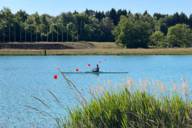
Just three kilometres from Schloss Schleissheim (Schleissheim Palace) is a relic of Munich’s 1972 Summer Olympic Games: the regatta rowing course in Oberschleissheim. The versatile facility continues to be well-used for sports and leisure activities today.
Around 41,000 spectators looked on from the stands with bated breath as the Olympics rowing and canoeing events took place. A car carrying four commentators accompanied boats on the 8-lane course to keep fans abreast of the action as it happened. That’s what the asphalt surrounding the 2000m x 140m waterway was intended for, though these days you’ll mostly see rollerbladers cruising beside the water when the weather is fine.
After the Olympic Games the course was used for the 1981 and 2007 World Rowing Championships, and has also hosted a total of 13 World Rowing Cup regattas between 1998 and 2012. What’s more, the Zentrale Hochschulsport (University Sports Centre) uses the (now heritage-listed) facility as a training course.
When the search began for a body of water that could serve as the Olympic regatta course in the late 1960s, none of Upper Bavaria’s many lakes fit the bill, because they could not meet the requirements of the international sports associations. It was eventually decided that creating an artificial lake on a site in Oberschleissheim was the answer.
With this site previously used for agriculture, the high groundwater level and proximity to a motorway made the location particularly favourable. The regatta course is situated six kilometres from the sports facilities in Olympiapark (Olympic Park) and has been carefully integrated into the surrounding landscape.
From the outset, Munich architects Eberl und Partner and landscape architect Georg Penker from Neuss considered the naturally grown structures in the landscape, ultimately opting to use wood as a building material and leave ample space for nature.
Their approach continues to prove valuable, as when there are no events taking place, locals use the lake area for recreation. Fish including trout, carp, pike, perch and eel thrive in the 3.5-metre-deep waters of the pool, while the surrounding meadows are vibrant with herbs, flowers and many species of butterfly.
In summer, bathing is permitted along the 500-metre strip in front of the viewing stands, and visitors can even bungee jump from a 50-metre crane, then take a dip in the Olympic waters of the regatta pool afterwards.